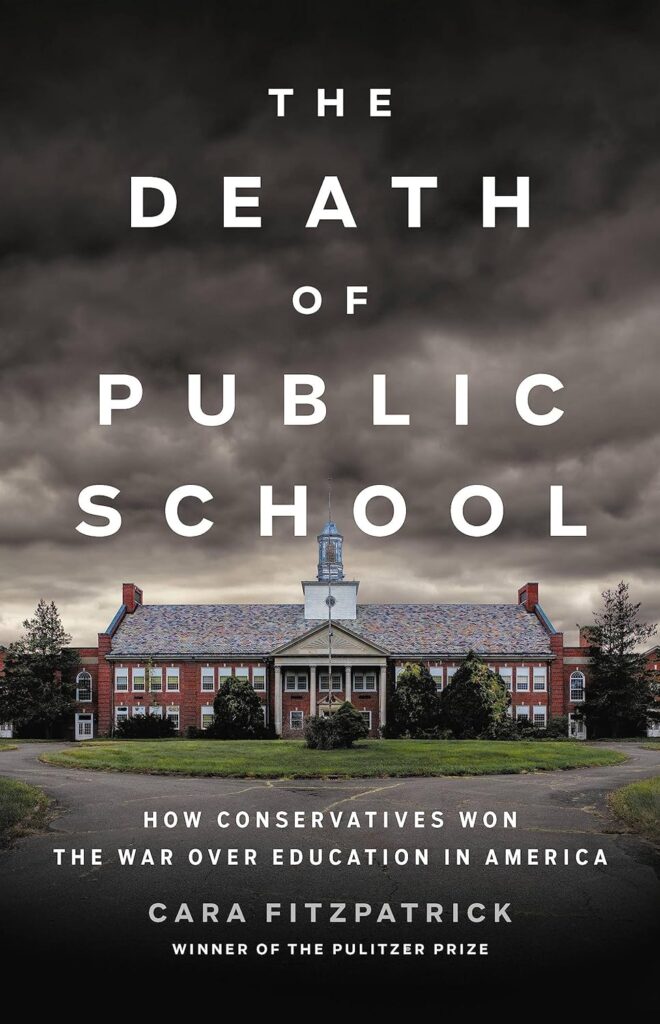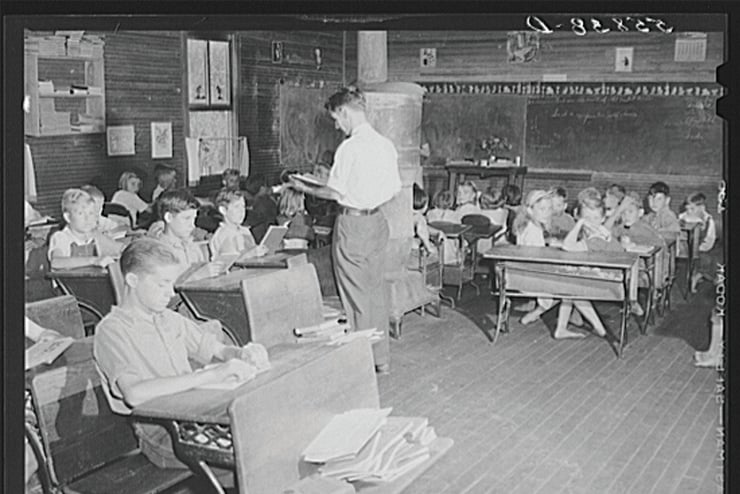This wildly exaggerated claim is more a call-to-action for progressives than a rigorous examination of reality.

The Death of Public School: How Conservatives Won the War Over Education in America
by Cara Fitzpatrick
Basic Books
384 pp., $32.00
Where a writer chooses to begin can tell you much about where she stands. In her book on the history of school choice, Cara Fitzpatrick starts with segregationist efforts in the 1950s to stave off the racial integration of schools. Her rhetorical intent is unmistakable. Surely, you see the conservative interest in school choice is genealogically linked to racism, yes?
It is no accident that Fitzpatrick had spent the previous several years prior to writing this book in Florida attacking officials there for “abandon[ing] integration” and thereby causing the problems in the state’s worst school districts.
The basic frame thus established, The Death of Public School then moves on to later efforts toward increased school choice rooted in free-market economic theory, religious liberty, and black identity politics. We encounter economist Milton Friedman, who in 1955 contributed one of the landmark interventions on this question with his book The Role of Government in Education. Friedman argued that a baseline of education is a desirable end for the whole of society. But a government monopoly on the content of education, or on the available selection of schools, will create the same undesirable consequences that monopolies produce elsewhere. Friedman advocated for parental school choice to ensure healthy competition in education.
Fitzpatrick also discusses Virgil Blum, a Jesuit professor of political science who advocated for school choice on religious liberty grounds, and Polly Williams, a long-term Democratic member of the Wisconsin State Assembly, who saw school choice as a potential route for poor black families to escape from disastrous urban public schools.
To Fitzpatrick’s dismay, these disparate ideological sources have slowly transformed America’s concept of schools from a social good into a private commodity. Somehow, though, there are still more than ten times as many American students in public schools than in private ones. It is thus less than clear that her book’s title stands up to reality. She concludes with a mournful account of Betsy DeVos’s appointment as Trump’s education secretary. The message is devised carefully for the ears of nervous progressives: The conservatives have won, and the public schools are finished. The unspoken challenge is: What are we going to do about it?!
Beyond a bare-bones introduction to school-choice proponents, Fitzpatrick makes no effort to substantively address their arguments. For example, Friedman’s view of school choice came from his libertarian economic perspective: All good parents want and work for the best for their children, which includes optimizing their educational environment. Unfortunately, not all parents are good parents. The children of bad parents can be predictably counted on to be bad students. They will be disruptive and problematic from an institutional standpoint. Once a school district has a critical mass of such bad parents and their bad students, the quality of education goes down for every student there. To eliminate the freedom of good parents and good students to escape such schools is ultimately to doom us all, he argued.
The progressive bias privileges a uniform, top-down, “expert” model of education as the best way to address the problems Friedman identified. It includes the added element that there must be disproportionate resources and attention focused on those students at the bottom, in the interest of equity. But individual parents have individual interests in their individual kids. Getting what the progressives want always requires the imposition of power against the interests of those parents.
Fitzpatrick presents Polly Williams as well-intentioned but uninformed. Williams viewed vouchers as a way to improve the academic performance of poor black students. The ceiling may well be fairly defined for most of those students, especially so long as their familial situations remain disproportionately mired in dysfunction. Yet, it is certainly the case that vouchers substantively help some of these students. Fitzpatrick makes no argument as to how it is morally sound to deny those families the right to decide how they will act on this possibility.
Readers of this book are led to believe that public school advocates are right to be horrified at the idea of religious schools accessing public funding, based on what Fitzpatrick calls the “traditional [understanding of] public education.” But it was only in the revolutionary 1960s that a small number of Supreme Court justices on the Warren Court gave us the educational world so adored by these progressives, in which public schools must operate at several arm’s-lengths from religion.
At the bottom of this debate about religion in schools is the question of the very purpose of education. Should schools in a modern society be entirely vocational or should they take on moral education too? Many parents desire that their children receive some moral teaching in accordance with the Judeo-Christian principles that were the cultural baseline for the country’s formation.
Fitzpatrick pretends there is a more venerable tradition of American thought that sees any moral education as illegitimate. She makes this feint while advocating for the antidiscrimination worldview that extended from the Civil Rights Movement of the 1960s. That belief system today takes a far more extreme form of multiculturalism and cultural relativism, such that it constitutes at the very least a quasi-religion—a religion bent on assaulting the moral system on which America was erected. But, since Fitzpatrick supports it, it is described as a “traditional” and perfectly legitimate aspect of a public education system.
The progressive bias is always toward the state and its appointed experts. Public education is always the solution, in all scenarios. Are schools underperforming? Well, then, they just need more money, or a more diverse teaching staff, or more nationalization of curriculum. More rigorous standards for students and objectively improved standards for teachers are never viewed by progressives to be viable solutions to educational problems. Those measures are discriminatory. They will have disparate impacts on minority students and teachers who perform less well on tests and in objective job performance criteria.
Progressives have discovered they can boost low student performance (albeit entirely artificially) and at the same time make room for teachers with lower academic qualifications. The mechanism is simply adding plenty of DEI (diversity, equity, and inclusion) material to the curriculum.
There are two final unquestioned axioms at the base of the progressive position on education. First, they assume that every young person in the country is capable of doing truly rigorous secondary and postsecondary schoolwork. Second, they believe that everyone needs a prolonged educational experience to have a productive and meaningful life. A never-ending extension of the years young people spend in officially sanctioned schools in front of well-trained ideologues of the progressive worldview—surely, no reasonable person could oppose such a wonderful thing!
Yet, massive evidence indicates that a significant number of young people are unsuited by temperament and intellectual ability for the kind of academic work done in college and in high school as preparation for college. Even when progressive philosophy dumbs down such work, many young people are still simply ill-suited for the task.
People used to rightly understand that youth who perform poorly academically were best suited to vocational training from an early age. When I attended high school, there were clear vocational tracks for such students. I remember seeing some of my fellows heading off to classes in auto repair or other such hands-on practical training in trades. There was no insult in such vocational tracking. It was widely recognized as an unqualified good for everyone involved, for those students as well as for the rest of society, which desperately needed such workers. It’s still true today.
But we moved away from our former commitment to this kind of vocational education. The justifications given were that it was unjust to educationally track students based on their aptitudes, that much of that trade work was made obsolete by technological progress, and that new immigrant labor pools were better suited to those fields.
But the arguments about technology were at best half-accurate, as many manual trades today are just as accessible to the 18-year-old of average intelligence as they were in the 1980s. And the competing immigration market argument is a smokescreen. If there are manual occupations suitable for the portion of American youth of which I am speaking here, why as a country are we allowing the interests of employers to chase them out of those fields by bringing in waves of uneducated migrants whom they can more easily exploit than native-born workers?
The manner in which the left has systemically distorted American labor markets through the immigration rules they have imposed plays a tremendous role in buttressing their claims about education. In this manner, they can reward their corporate donors and their public-sector education union bureaucrats. They are also satisfying the voracious appetite of the American diversity apparatus and extending the period of youth indoctrination into the progressive worldview. Even if many students remain utterly academically incapable, some can at least be shuttled into DEI jobs. Universal Basic Income is coming for the remainder.
Fitzpatrick, predictably, does not discuss any of this. Her index contains only two fleeting hits for “immigration.” Neither points to this relationship between progressive support for always-expanding public education and our wide-open borders. Progressive histories never fail in this way to occlude the real ends of progressivism.

Leave a Reply